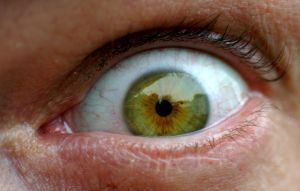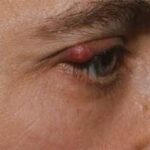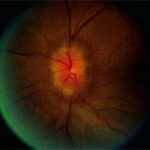I knew there was a problem the minute I opened my eyes.
My right eye felt vaguely annoying. Maybe I wore my contacts too long over the weekend, I reasoned as I reached for my glasses. Or maybe I didn’t clean my contacts well enough.
I headed to work wearing my very thick glasses. Two days later, I found myself filling out a medical history in an ophthalmologist’s office. I had a pounding headache. As my eye started to swell shut, I was convinced I was suffering from some type of monster sty. Although I’d had a few as a child, this wasn’t the problem.
The verdict: a chalazion. It’s a hard lump that forms in one of the oil-producing glands around the eye, the doctor told me. Mine was actually situated between two eyelashes on my lower eyelid. Although it didn’t itch, the urge to rub it to relieve the discomfort was almost overwhelming.
According to Jacqueline D. Griffiths, MD, in Optical Insights, once in a while, an oil gland around the eye gets plugged. The result is a bump resembling a pimple. It looks pretty innocent at first, but if it gets infected, you’re in for some major soreness.
It didn’t take me long to decide not to wear my contacts for a while. According to Dr. Griffiths, your red, swollen eye could even become sensitive to light. In severe cases, you might find you have blurred vision due to pressure exerted by the inflammation on the eye and the chalazion as it increases in size.
The article suggests you can treat most chalazia at home. You need to use warm compresses and gently massage the area to loosen any plugged glands. Although it also states most of these unsightly bumps disappear within a few weeks, mine was stubborn and required a repeat visit to the ophthalmologist.
How do you decide when to see a medical professional? According to eMedicineHealth, you need to visit an ophthalmologist if the redness or swelling in your eyelid shows no improvement once you’ve been using warm compresses for three or four days. It suggests you should also get in touch with your ophthalmologist right away if you note frequent instances of swelling of your eyelid or if you experience fever, headache, visual changes such as blurred vision, eye pain or drainage, extensive redness or even swelling, swelling of both eyes, or swelling of both the upper and lower eyelid of the same eye. If you suffer from any of these symptoms and cannot reach your ophthalmologist, you should get help at a hospital emergency department.
How will an ophthalmologist treat a stubborn chalazion? Often antiobiotics are prescribed. Severe cases call for surgical draining, usually in the physician’s office. Should the chalazion return or if you develop more over an extended period, the ophthalmologist might elect to submit the specimen for testing at a laboratory.
Ultimately, I got lucky. Although I was scheduled for surgery, the morning of the appointment, I looked in the mirror to discover my unsightly bump had decided to drain on its own. I kept the appointment and continued to avoid wearing my contacts for a full two weeks more.
Reference:
- Optical Insights article




